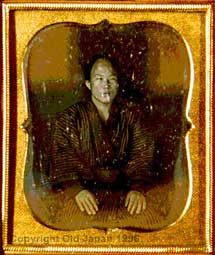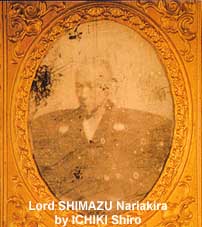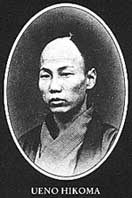PhotoHistory 1646-1867
Chronological history of photography in Japan in 1646-1867 (Pre-Meiji Period)
Researched and compiled by Philbert Ono
1646
The camera obscura arrives in Nagasaki via the Dutch settlement.
1788
OTSUKI Gentaku, an apprentice of SUGITA Genpaku, describes in an essay the camera obscura, hitherto called a "donkuru-kaamuru" in Japanese, based on the Dutch pronunciation. He also uses the term "shashin-kyo" (photo mirror) as a Japanese translation for "camera obscura."
1815
In a Dutch studies publication he issued, SUGITA Genpaku translates "camera obscura" as "anshitsu shashin-kyo" (darkroom photo mirror).
1843
In Nagasaki, UENO Shunnojo-Tsunetari (1790-1851) (father of UENO Hikoma), a trader, brings a daguerreotype to Nagasaki, but it was not unloaded. (The daguerreotype was first introduced in Paris in Aug. 1839.)
1848
In Nagasaki, UENO Shunnojo-Tsunetari (1790-1851) (father of UENO Hikoma), a trader, imports Japan's first daguerreotype camera from Holland (his second attempt), the only Western country Japan could trade with. Although Ueno had brought a daguerreotype to Nagasaki 1843, it was not unloaded.
1849
Lord SHIMAZU Nariakira, daimyo of the Satsuma Clan in southern Kyushu, acquired a daguerreotype from UENO Shunnojo-Tsunetari and experimented with it. He did not succeed so well because the camera was probably defective. In 1858, Lord SHIMAZU perhaps took a collodian photograph of three women, titled "Three Princesses." The image is kept at the Shimazu family museum in Kagoshima.

1851
The Eiriki-Maru, with a crew of 18 Japanese, got shipwrecked in the Pacific Ocean and was brought to San Francisco in Feb. 1851. The rescued crew were among the first Japanese to visit the U.S. even before Japan's first official diplomatic mission that visited in 1860.
The crew stayed in San Francisco until March 1852 when they were taken to Hong Kong. Harvey R. Marks (1821-1902), a photographer from Baltimore, photographed the castaways (including Sentaro or Sampachi/Simpatch, the ship's cook nicknamed Sam Patch who accompanied Commodore Perry's squadron to Japan) and thus became the first to photograph Japanese subjects.
A few of the daguerreotype portraits have survived, now in the possession of the Kawasaki City Museum and the Yokohama Museum of Art. Read more in an article by Old Japan.
The January 22, 1853 issue of Illustrated News published in New York carried an article about the Eiriki Maru crew members along with woodblock reproductions of the crew's portraits.
1853-1854
Commodore Perry's naval squadron arrives in Japan and the official photographer, Eliphalet Brown, Jr. (1816-1886) took some 200 daguerreotype photos of people and scenics in Shimoda (Shizuoka Pref.) and Hakodate (Hokkaido). He thus became the first person to photograph the Japanese in Japan. Some of these images were used to make lithographs which found their way in A Journal of the Perry Expedition to Japan 1853-1854 by Samual Wells Williams, published in 1856. The print shop which printed this document was destroyed by fire and almost all of Brown's original daguerreotypes were lost. Only five are known to have survived.
Perry's mission led to the opening of Shimoda (Shizuoka Pref.) that year and of Hakodate in Hokkaido in 1855 as treaty ports.
After Perry left Japan, a Russian ship with photographer Captain Aleksander Mozhaiskii arrived. He took daguerreotype photos in Japan. One of the images is preserved at Gyokusenji Temple in Shimoda, Shizuoka Pref.
1856
American consul Townsend Harris and Dutch interpreter Henry Heusken arrive in Japan. Until 1859, they are the only Western foreigners living in Japan outside Dejima, Nagasaki. Heusken teaches basic photography to SHIMOOKA Renjo in Shimoda. Shimooka later moved to Yokohama and opened a photo studio in 1862.

1857
Scientist ICHIKI Shiro of Satsuma (Kagoshima Pref.) takes a portrait of SHIMAZU Nariakira, the lord of the Satsuma fief in southern Kyushu. This portrait is the oldest surviving daguerreotype (see the image) by a Japanese photographer.
Naval doctor Julius L. C. Pompe van Meerdervoort starts teaching photography at the Medical Institute in Nagasaki, the center of Dutch learning. Among his students were UENO Hikoma, UCHIDA Kuichi and MAEDA Genzo. Meerdervoort and other foreigners introduce the wet-collodian process around this year and up to 1859. The three treaty ports of Yokohama, Nagasaki, and Hakodate become the centers of photographic learning in Japan.
1858
American Consul Townsend Harris succeeds in obtaining a new treaty with Japan for trade at Hakodate, Yokohama, and Nagasaki. Other countries also conclude treaties with Japan, opening the country to foreigners from July 1859.
1859
With Western foreigners at the treaty ports, they take many photos of Japan. But few of the earliest ones survive. Orrin E. Freeman, an American, is the first person to engage in professional studio photography in Yokohama.

1862
UENO Hikoma (1838-1904) (father UENO Shunnojo Tsunetari), after learning photography and chemistry under Dr. Pompe van Meerdervoort, publishes the treastise, Seimikyoku Hikkei which described photographic techniques and the wet collodian process.
UENO Hikoma becomes one of the first professional Japanese photographer by opening a photo studio in Nagasaki called Ueno Satsuei-kyoku.
SHIMOOKA Renjo (1823-1914) opens a photo studio in Yokohama after learning photography from "Unshin," thought to be Captain John Wilson, an American who sold his equipment to Shimooka upon leaving Japan.
Englishman William Saunders, a Yokohama resident, takes a number of photographs during a three-month stay from Aug. 1862. He goes to Shanghai, China and becomes famous for Chinese photography.
Until the Meiji Restoration in 1868, early Japanese photographers serve the foreign community almost exclusively since foreigners were the ones who could afford to have a portrait taken. The Japanese believed that being photographed would bring death or illness. From 1865, such superstitions were dispelled and more Japanese started to have their portraits taken.

1863
Charles Parker arrives in Japan and stays until about 1868. He operates a studio in Yokohama. Only a few of his photographs survive.
Felice Beato, a famous Italian photographer, comes to Yokohama and stays for 21 years. A substantial amount of his work survives. His Japanese portraits and scenics are highly evaluated. His portraits were hand-colored. This practice was popularized by him. He traveled widely in Japan and built up a large stock of photos which he sold from his studio.
1864
KIZU Kokichi opens a photo studio in Hakodate (Hokkaido), one of the ports which were opened to foreigners.
1865
UCHIDA Kuichi, who studied under UENO Hikoma, and NAKAGAWA Shinsuke both open a studio in Osaka.
HORI Yohei (Masumi) opens a photo studio in Kyoto.
1866
TOMISHIGE Rihei opens a photo studio in Yanagawa, Kyushu.
A fire besieges Yokohama and Felice Beato's photo studio is burned down. The studio is back in business by 1868.
1867
Imperial rule is restored to Emperor Meiji.
Next: PhotoHistory 1868-1919